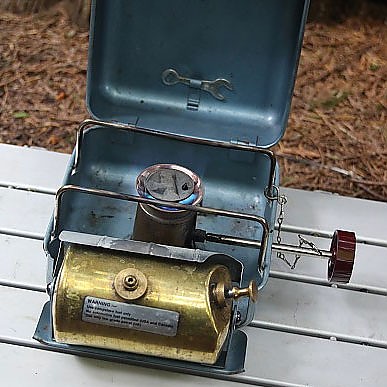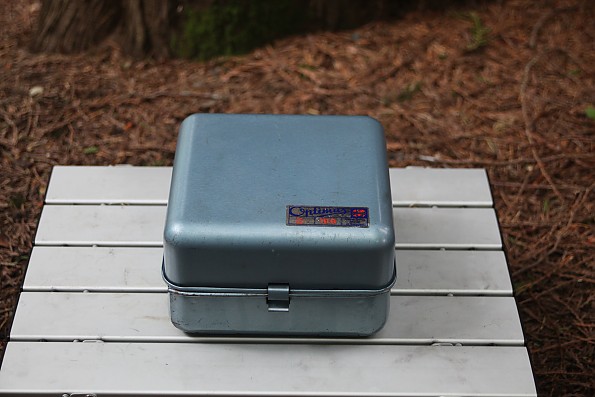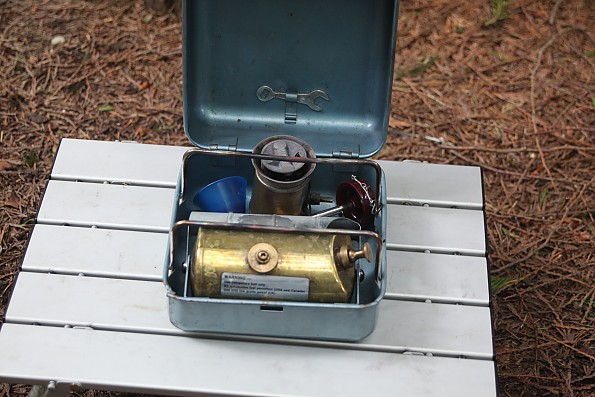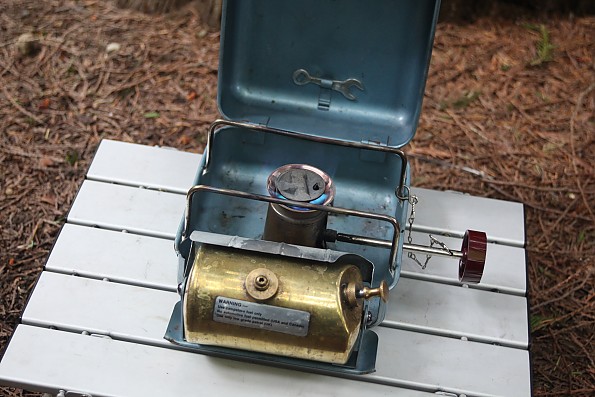Optimus 111B

It is rare in today’s outdoor market for a product to continue with few changes for more than a score of years or even a decade. Stoves are a bit different, requiring more R & D, as well as being based on a couple of basic designs. The Optimus 111B is a design that dates in nearly unchanged form to the 1920s and still performs well to this day.
Pros
- Requires minimal assembly
- Boils water quickly
- Stable
- Able to use large pots
- Precise flame control
- Extremely reliable
Cons
- Expensive
- Heavy
- Only available used
- Roarer burner is noisy
Background:
Early pressurized stoves date back to the late 19th century. No one can say for certain who developed the first one, but by the end of the century Optimus was one of the leading names. Those early stoves used kerosene (parafin), but by the early 20th century white gas (Coleman Fuel, naphtha) was becoming more common.
In 1927, Optimus of Sweden patented their No. 11, a box stove that would burn either white gas or kerosene. It was encased in a tin box with a brass fuel tank and a simple roarer type burner. An integral pump supplied pressure and the hinged lid of the box provided an effective windscreen. By 1953, the No. 11 had been superseded by the 111, again a dual fuel stove but with an integrated cleaning needle.
A short time later, Optimus changed their 111 to a 111B model which only burns white gas. It has been surmised that the 111 and 111B models were nearly identical except that the B model was said to be only for white gas. The earlier 111 would burn both kerosene and white gas using the same jet, which may have been an issue with both. Production of the 111B was discontinued in 1999 and a new variant, the 111C was introduced.
My own background with stoves began with Bluet canister stoves in the early 1960’s. Climbing friends used everything from SVEA 123’s to Optimus 8R’s(small variants of the 111) and MSR XGK’s, when those latter stoves first emerged. I eventually settled on a SVEA 123R as my climbing and hiking stove. My own personal experience with the 111 began when I started going on extended canoeing expeditions in Canada’s North.
At that time, I needed a stove that was simple, would simmer well, was efficient and would serve as the primary stove for a group of six. Weight was less of an issue than if I were carrying everything on my back. The stove also had to be very reliable. The 111 in it’s various forms, has been supplied to the Swedish Army, NATO forces, and developing nations. It has also been on a number of major Himalayan and Antarctic expeditions as a primary stove.
Initial Impression:
This is not a lightweight stove. At 58 oz./1640 grams, it is made from heavy metals, including a brass tank and steel case. The integral tank includes a pump with a brass handle and a steel shaft, a pressure relief valve, the body of which is also brass. A steel shield protects the tank from the heat of the burner assembly and from reflection of large cooking pots.A regulator knob is fitted to the burner assembly through a hole in the right hand side of the case when in use.A chrome steel chain prevents it from being lost. A small wrench is clipped to the inside of the case lid. The stove can be fully field stripped using only this wrench.
The burner assembly is a roarer type with a metal plate being rigidly supported by two cast arms above the jet. A small pan below the burner assembly acts as the support for the burner, as well as a cup to hold priming fuel. Two chromed steel pot supports fit into recesses in the bottom of the case. The case lid acts as a windscreen. As well, a small windscreen is fitted below the burner plate. A small carrying handle is located above the hinges at the rear of the case.
In the Bush:
To operate, the case with the stove inside is placed on a level surface, with the hinges toward any wind. The lid of the case is opened by means of a small retaining latch at the front and the lid is hinged up until vertical. The regulating knob is lifted out and placed to the right side of the case. The front of the case base is hinged and when lowered, the tank and burner assembly slide forward with the burner positioned under the pot supports.
The regulator knob shaft is inserted through the hole in the case on the right side and fits over the square profile of the regulator valve on the burner assembly. The knob is turned clockwise to insure that the regulator valve is in closed position. The tank filler cap with integral pressure relief valve should be unscrewed to check that the amount of fuel in the tank is adequate for task of cooking.
The capacity is 12oz./.035L which gives a burn time at maximum output of up to two hours. Replace the filler cap snugly. The pump, located on the right hand end of the tank is pumped slowly 12-15 times. Next, the regulator valve is opened slightly and liquid fuel is allowed to nearly fill the priming cup at the base of the burner assembly. Close the valve. Using a match, lighter or fire starter, light the liquid fuel. There will be some flare up as this is white gas, so don’t be too close. When the flame in the priming cup is nearly gone, open the regulator valve and the burner should respond with a roar. It may sputter slightly before coming to a constant roar. If the flame in the priming cup is extinguished completely before opening the regulator valve, it will be necessary to light the stove at the burner plate.
Occasionally, especially in extreme cold, the stove will still not be adequately primed and the priming cup must be filled again. The priming step is necessary to heat the burner assembly so that fuel leaving the burner jet is vapor, rather than liquid.
Once the stove is operating, noted by the constant roar, the regulator knob is used to control the flame. The 111B will boil a liter of water in under 3 minutes, and unlike many other stoves, will also simmer well. As the fuel level in the tank drops, more pressure can be added by a few strokes on the pump. Should the burner jet become clogged, turning the regulator knob all the way counter clockwise will bring the integral cleaning needle through the orifice, clearing the obstruction.
Weekly, the pump leather should be lubricated with a small amount of oil.
I have used my Optimus 111B on a number of trips. Although heavier than many other stoves, it performs well for cooking, as it is stable, can go from a boil to a simmer, has the ability to hold large pots. For trips such as my canoe expeditions in Northern Canada or my winter ski trips where I pull a pulk, the 111B is a wonderful stove. It needs little assembly. Its only limiting factor is its size and weight. If you have the ability to carry a stove of this weight, it is a pleasure to cook on.
Optimus 111B
Fuel:White gas/Naphtha
Weight:58oz./1640 g
Measurements:4.1 x 7.1 x 7.1”/105 x 180 x 180mm
Rating:Approximately 3,000 watts/10,000 BTU
Running Time:Up to two hours at maximum output
Boiling Time 1 L Water:Down to under 3 minutes(varies with climate, altitude, etc.)
My Experience:
Since the early 1960s I have hiked, climbed, skied and paddled over much of the Northwestern part of North America. In the early 1990s I retire from more extreme mountaineering and now spend a large portion of each year canoeing Canada’s Far North.
Source: bought it used
Price Paid: $120 US
Classic design, engineering, and reliability.
Pros
- Quality built
- Reliable
- Powerful
Cons
- Expensive
- Hard to find in USA
I cannot add much to the previous review which is very thorough.
The 111T burns alcohol, kerosene, or Coleman fuel with a change of the jet and air baffle. The T has a silent burner in place of the roarer burner on the B. The 111B is a Coleman fuel stove. As Erich points out, the CF burner has only one set of vaporizer tubes and the kerosene burner has two sets of vaporizer tubes.
I own both of these stoves and they are prized possesions for any camper (or stove collector). If you buy a used one, plan on replacing some rubber parts and the pump cup (all are still available at very modest cost).
Visit www.spiritburner.com for instructions on how to "fettle" this stove. Given just a little TLC it will run for many more years.
Source: bought it used
Price Paid: $125
I have a version before this one, where the tanks stays within the square bottom enclosure.
It doesn't have a knob but a very small key, which isn't so nice to use when you have a larger pan and everything is very hot. Anyway after more than 35 years, it is still working as almost new. How is that for reliability?
Pros
- Extremely reliable
- Hardly any maintenance
Cons
- The key fob is not so nice, and rather small to get your hands so close to the heat.
- The square aluminium canister as a pan is somewhat to get used to.
Guess what my next stove was when I tossed the Coleman multifuel after just a year or so?
Right! An Optimus again.
Source: bought it new
Price Paid: ???
Pros
- Easy to use, maintain, and carry.
Cons
- None
Summer 1972, my wife and I motorcycled from Los Angeles, Calif., to Anchorage, Alaska, and back on a BMW R75/5. Our only source of cooking heat was an Optimus 111B, which performed trouble-free the whole time we were on our adventure.
We used it for cooking all sorts of meals, heating bathing water, and even used it to heat the crankcase of the BMW when near freezing weather made it impossible to start the bike in the morning when the oil was too thick for a battery or kick start. A friend who loaned us the stove said it would even run on pump gas, so we drained enough to fill the stove from our gas tank.
We can only praise this stove as the best and most reliable for any expedition.
FRED KERPSIE Acton, California
Source: borrowed it





